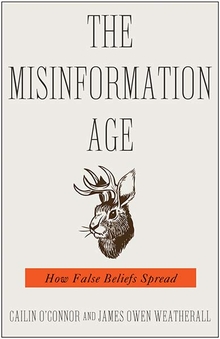Mercury in Fish
Cailin O’Connor and James Owen Weatherall—
Elemental mercury is the only metal that is liquid at room temperature. Aristotle called it “quicksilver,” a term that captures its strange beauty. But this particular beauty is also deadly. Exposure to mercury can lead to a host of symptoms: sensations of bugs crawling under the skin, extreme muscle weakness, hair loss, paranoia, mental instability, and, for high exposure levels, death.
The history of mercury use is riddled with such poisonings. Qin Shi Huang, the first emperor of a unified China, is reported to have died in 210 BCE after taking mercury pills that ironically were intended to make him immortal. Isaac Newton sank into paranoia and insanity at the end of his brilliant life—likely a result of his experiments with mercury. (Posthumous hair samples revealed highly elevated levels of it.)
By the end of the twentieth century, the dangers of mercury were well established, and its use was heavily regulated in the United States, Europe, Japan, China, and elsewhere. Mercury poisoning should have been under control.
And yet beginning around 2000, an American physician named Jane Hightower began to notice a distinctive cluster of symptoms in her patients: hair loss, nausea, weakness, brain fog. These are all associated with mercury poisoning—but these patients did not have lifestyles that should have brought them into contact with heavy metals, and so the diagnosis did not occur to her. Until, that is, a colleague heard a story on public radio about a town where locals suffered hair loss and other ailments of mercury poisoning after eating contaminated fish. On a hunch, this colleague ordered a mercury test for one of Hightower’s patients.
Sure enough, the patient’s mercury levels were elevated.
The patient also ate a lot of fish. Armed with a new hypothesis, that the strange symptoms were linked to mercury and perhaps to fish, Hightower went back to her other mystery patients with a new question. How often did they eat fish? As it turned out, those patients tended to be wealthy and health-conscious and chose to eat fish very often—including many fish high on the food chain, such as shark, swordfish, and tuna.
Over the next few years, Hightower systematically recorded her observations and shared her suspicions with colleagues, including some EPA officials who worked on mercury contamination in seafood. Some of the doctors she spoke with began to look for evidence of mercury poisoning in their own patients. Obstetricians in her hospital warned pregnant women off certain fish, since fetal brains are particularly susceptible to the effects of mercury. Some doctor friends quit eating predatory fish. The hospital cafeteria stopped serving canned tuna.
A local news station ran a story on Hightower’s suspicions. Then 20/20, a national television news program, ran a segment on mercury poisoning and fish. Television crews performed tests of the mercury levels in fish at local supermarkets and discovered that some of them, especially shark and swordfish, were well above levels deemed safe by the US Food and Drug Administration (FDA). Their coverage of Hightower’s claims reached a wide audience—and soon more doctors were monitoring their patients for fish-related mercury poisoning, gradually accumulating a larger and larger body of evidence supporting Hightower’s hypothesis.
We often associate scientific discovery with lone geniuses—mercurial madman Isaac Newton, Charles Darwin, Albert Einstein—who, in a moment of revelation, conceive of some new theory fully formed. But real discoveries are far more complicated and almost invariably involve many people. Most scientific advances result from the slow accumulation of knowledge in a community. Guesses and observations come from many directions. These insights gradually spread and accumulate, leading to yet more hypotheses and new ideas for how to gather evidence. Only after a long and collaborative process can we say that scientists have achieved a new discovery. Crucial to this process is the network of human interaction linking scientists to one another.
Although Jane Hightower led the effort to link mercury poisoning with overconsumption of contaminated fish, she did not act alone. It was a colleague who first connected hair loss in Hightower’s patient with mercury poisoning. It was a contact at the EPA who, upon hearing about her work, shared recent government studies on mercury in fish. Other doctors informed her of patients with similar symptoms, improving her understanding of the syndrome. Hightower’s thinking was informed at every step by evidence from outside her own experience.
Conversely, Hightower’s insights helped others make even more progress. As soon as she started to gather evidence, her work began influencing the beliefs and behaviors of those around her—obstetricians, other clinicians, medical associations—who went on to find more evidence and further links. Ultimately, the discovery of a new link between mercury poisoning and seafood consumption occurred when a community, or network, of scientists and doctors, all sharing ideas and evidence, adopted a new consensus.
In this way, those responsible for scientific discovery are bolstered by those around them. Bolstered—but also, sometimes, stymied. Hightower’s evidence did not convince everyone she shared it with. To many colleagues, she seemed like an activist with some kind of environmentalist axe to grind, or perhaps just a quack. In fact, there seemed to be good reasons to think that the symptoms Hightower observed could not be from mercury.
In the early 2000s, it was already widely known that some fish contained mercury. Coal-fired power plants emitted a form of inorganic mercury into the air, where it would gradually fall back to earth, mix into ocean water, and be ingested by microbes, which converted it to highly toxic methylmercury. These microbes would then be consumed by small fish, which would be consumed by larger fish, and so on up the food chain. Methylmercury tends to accumulate in animal tissue, so large fish were building up high levels of the toxin. This was why the FDA already had guidelines regulating the level of methylmercury in fish sold commercially—levels that, it turned out, were exceeded by some supermarket supplies.
So the idea that fish contained toxic mercury was not controversial. But precisely because the whole process seemed well-understood, regulators, including the FDA, thought they knew what the dangers were. When presented with Hightower’s work, the FDA responded that no one was actually eating enough fish to be poisoned. Many of her colleagues seemed to agree.
Still, Hightower pushed forward with a year-long survey documenting the fish intake, symptoms, and blood mercury levels of a group of patients. She published these results and shared them with a contact at the EPA, who invited her to present her work at a meeting of mercury experts. At the suggestion of another colleague she wrote a resolution about the dangers of methylmercury and how to tackle them, which was passed by the California Medical Association and San Francisco Medical Society.
With time and ever more evidence, she gradually convinced more and more of her colleagues. Today, government agencies around the world are more savvy about the risks of methylmercury poisoning from fish and have issued guidelines to better control exposure.
From The Misinformation Age by Cailin O’Connor and James Owen Weatherall. Published by Yale University Press in 2020. Reproduced with permission.
Cailin O’Connor is associate professor of logic and philosophy of science at the University of California, Irvine. James Owen Weatherall is professor of logic and philosophy of science at the University of California, Irvine, and author of the New York Times best-seller The Physics of Wall Street. Both are members of the Institute for Mathematical Behavioral Science.
Further Reading:



























